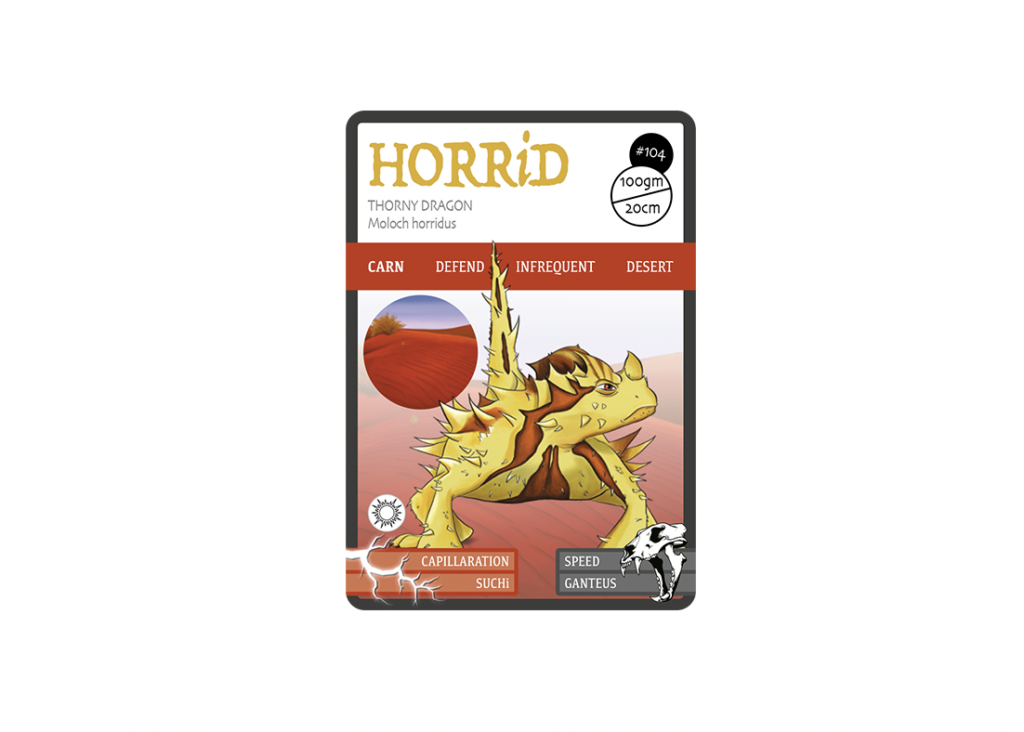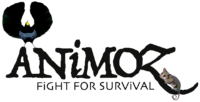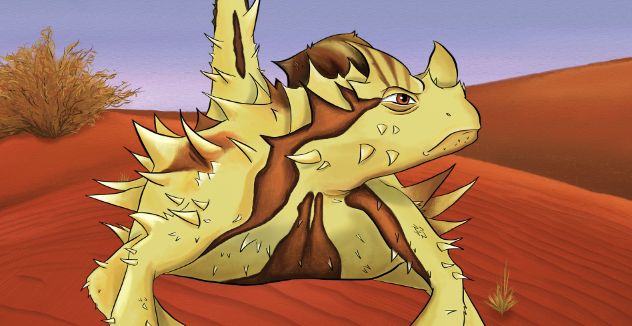HORRiD is the thorny dragon (Moloch horridus)!
Species report on the thorny devil
-
- A real-life dragon with fantastic superpowers lives in the Australian desert!
- Horridus – their scientific name – means “bristly”, named for their spikey appearance
- The thorny dragon only eats ants, and can only feed when the temperature is above 24 degrees!
Deep in Australia’s sandy deserts lives a tiny dragon. Impressively spikey and colourful, HORRiD has several incredible adaptations.
The thorny dragon, also known as the thorny devil, is only about 20 centimetres long and weighs less than 50 grams! He is covered in fearsome spikey scales, and even has ‘horns’ on top of his head!
The scales are a bit deceptive because they’re not actually very rigid; if you run your fingers along the back of a HORRiD the scales will bend slightly. Their appearance and bumpiness is enough to reduce their appeal to predators though, who find swallowing them very difficult due to their uneven texture.
The Horridus part of HORRiD’s scientific name literally means “bristly”!
Where is the thorny devil found?
HORRiD are only found in the deep deserts of central Australia, and rarely in mallee country. Their distribution is better explained by soil type than it is by climate: They are only found in areas with deep sandy soils.
Their colour varies with soil colour, as well as seasonally with temperature. HORRiD can appear mixes of brown, grey, red, yellow or orange. Often, they appear darker in the early morning and become more vibrant as the temperature increases!

What does the thorny dragon eat?
HORRiD only eats ants. In fact, she only eats ants that are moving in a straight line! She will stand over a line of ants and pick them off one-by-one. Typically, the thorny dragon will eat 2.9 ants per minute, but some have been observed eating one ant per second… that’s 60 ants per minute!
To survive, the thorny devil needs to eat about 750 ants per day. That’s a lot of SUCHi in the diet!
An unusual adaptive trait of HORRiD is that they will only actively feed if the temperature is 24 degrees Celsius or higher. Below 24 degrees they require too much energy to maintain their body temperature, and are better off hiding in their burrow or basking in the sun.
Fun facts about the thorny dragon…
HORRiD activity is seasonal; they’re most active March-May and August- December. They become almost completely inactive January and February because it is too hot, and then inactive again through the winter when the temperature falls below 24 degrees.
Not much is known of HORRiD’s mating and reproduction habits. From observations in captivity and limited observations in the wild, ecologists and researchers understand that they mate and lay eggs in late winter through early summer.
Female thorny dragons are larger than males due to the energetic costs of having to lay eggs. Females are up to 45 grams whereas males only weigh up to 31 grams. Females lay 3-10 eggs in a burrow about 15 centimetres long, and the eggs incubate in the burrow for about 4 months.
Baby thorny devils are independent immediately but are only 2-3 grams and about 6 centimetres long!
HORRiD has a tiny home range, averaging 100 square metres! His average daily movement is only 78 metres, and he moves very slowly in a forward-back, side-to-side rocking motion, standing still for several moments at a time.
This pattern of motion is thought to confuse their predators, making them hard to distinguish from the background and appearing like a leaf or plant moving with the breeze! HORRiD is predated by GANTEUS the perentie, AUDAX the wedge-tailed eagle, and other larger lizards and birds, as well as snakes like MENGDEN the western brown snake and LEPiD the inland taipan.
What is the thorny dragon’s Superpower?
An incredible adaptation HORRiD has is her Capillaration Superpower: Living in the desert where rain and pooled water is scarce, HORRiD have turned into their very own drinking straws!
The thorny dragon doesn’t directly drink water, even when there is water lying on the ground. Instead, the ridges on their scales channel the water upwards towards their mouth. When there is no water lying around, HORRiD’s scales work in the same way to capture morning dew and draw it towards their mouth!
That’s right: HORRiD the thorny devil pulls water up her body, against gravity, so that she can keep an eye out for predators!
An amazing adaptation to ensure their survival in the desert.
Read more species reports from ANiMOZ Ecologist, Ranger Tessa here:
Have you ever seen HORRiD in the wild? Make sure to share your photos and tag #wildANiMOZ!

